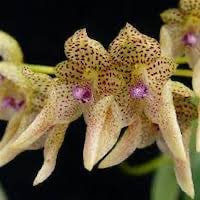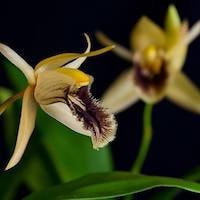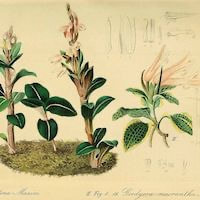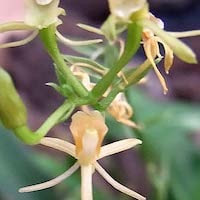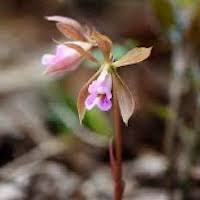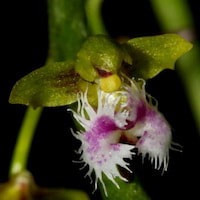WWD3- Women's Woody 3 - Silence of a mid-night beach
|
Native Singaporean Orchid notes: Dendrobium Leonis
Dendrobium Leonis, also known as Lion's Dendrobium, is cherished for its aromatic qualities and is featured in the fragrance "Woody 3 (Women)" for a team-building perfume workshop. It is recognized in Thailand for its medicinal value in treating headaches. The orchid's petite flowers, measuring 1.3 to 2.0cm, display delicate pale green or yellow petals with a lip tinted in very pale green and dark purple. Known for its sweet vanilla fragrance, creators also detect hints of chocolate, likening its overall scent to a joyful baby rabbit, embodying cheerfulness and playfulness.
|
Therapeutic Orchid notes:
|
Bulbophyllum umbellatum
Bulbophyllum umbellatum, also known as Cirrhopetalum maculosum, is an orchid species native to the western Himalayas and Thailand, known for its distinct fragrance. One of its notable compounds is cirrhopetalanthrin, a dimeric phenanthrene derivative. This compound is used in Ayurvedic preparations known as "swarna jivanti," valued for promoting longevity and well-being. The roots of Bulbophyllum umbellatum are also esteemed for their longevity-promoting properties, traditionally used to enhance vitality and overall health. Research underscores its role in traditional medicine, particularly in Ayurveda, highlighting its therapeutic potential. |
|
Coelogyne ovalis Lindl.
Coelogyne ovalis, known as Changlinbeimu Lan in Chinese and Jeevanti in India, is an orchid species celebrated for its fragrance and medicinal potential. Phytochemical studies have identified beneficial compounds like 2,7-dihydroxy-3,4,6-trimethoxy-9,10-dihydrophenanthrene, coelogin, and flavidin, among others. In Indian tradition, Jeevanti is renowned for promoting vitality and treating ailments such as coughs and urinary infections. In Nepal, its pseudobulbs are considered aphrodisiacs. The orchid's diverse medicinal uses highlight its cultural significance and therapeutic value in traditional practices. |
|
Goodyera biflora (Lindl.) Hook f. Syn. Goodyera pauciflora Schltr.
Goodyera biflora, also known as Danhuabanye Lan or Big Flower Spotted Leaf Orchid in Chinese, is a terrestrial orchid species found in regions like Nepal, Bhutan, India, China (including Sichuan, Yunnan, and others), Japan, and Korea. In traditional Chinese medicine, it is valued for treating conditions such as haemetemesis (vomiting blood) related to tuberculosis, anorexia, and neurosis. The plant is believed to nourish yin, benefit the lungs, detoxify the body, and treat ailments like snake bites and ulcers. Its use in both internal and external applications underscores its cultural importance and medicinal potential across different traditional practices. |
|
Liparis petiolata (D. Don) P.F. Hunt & Summerh.
Liparis petiolata, known as Bingyeyangersuan in Chinese or Handle Leaf Sheep Ear Garlic, is a terrestrial herb with ovoid pseudobulbs. It thrives near streams at altitudes of 1000 to 2900 meters in China's Hunan, Jiangxi, Guangxi, southern Yunnan, and southeast Xizang provinces. This orchid also grows in Vietnam, Thailand, Bhutan, Nepal, and northeast India. In traditional medicine, it is used for lung-related benefits, reflecting its potential role in supporting respiratory health across various cultural practices and regions. |
|
Nervilia plicata (Andr.) Schltr. Syn. Nervilia purpurea (Hay.) Schltr.
Nervilia plicata, known as Maoyeyu Lan or Qingtiankui in Chinese, Padmacarini in Sanskrit, and Oarilai thamarai in Tamil, is a culturally significant orchid species found in deep forests across Asia and Australia. It thrives in rocky, humus-rich soils in regions from Bangladesh to Indonesia. Depending on light conditions, its leaves can range from deep purple to green. In Traditional Chinese Medicine, it is used to clear lungs, ease coughs, and detoxify. In Ayurveda, it features in preparations like Priyagvadignana for various ailments, including diabetes and skin diseases. The Poliyar tribe in India uses its leaves for medicinal pastes, highlighting its diverse traditional uses across different cultures. |
|
Ornithochilus difformis (Wall ex Lindl.) Schltr. Syn. Ornithochilus fuscus Wall ex Lindl.
Ornithochilus difformis, also known as Yixingxiachun Lan or Yuchun lan in Chinese and Soi Thong in Thai, is an orchid species with distinctive traits and wide geographical distribution. It blooms at different times across its range: from February to April in the Himalayas, May to July in China, and July in Peninsular Malaysia and Thailand. Its unique floral structure gives rise to its Chinese names reflecting its narrow or feather-like lip. In traditional Chinese medicine, the whole plant is used to treat rheumatism, arthritis, and soft tissue injuries, collected from provinces like Guangdong, Guangxi, Yunnan, and Xizang. Overall, Ornithochilus difformis is valued for both its appearance and medicinal benefits in managing musculoskeletal ailments. |
Other scent note
Smoky, woody, sweet, balsamic, resins with hint of herbaceous woods, Belambra tree, Larch, Neem, Muhuhu
Scentopia Library Reference ingredient
Fiddle Wood - Sentosa's Plants - Check details at Scentopia's scent library
Download the guided mediation that works best with this Orchid fragrance oil
| women_woody_essential_oil_orchi_00003.mp3 | |
| File Size: | 163884 kb |
| File Type: | mp3 |

